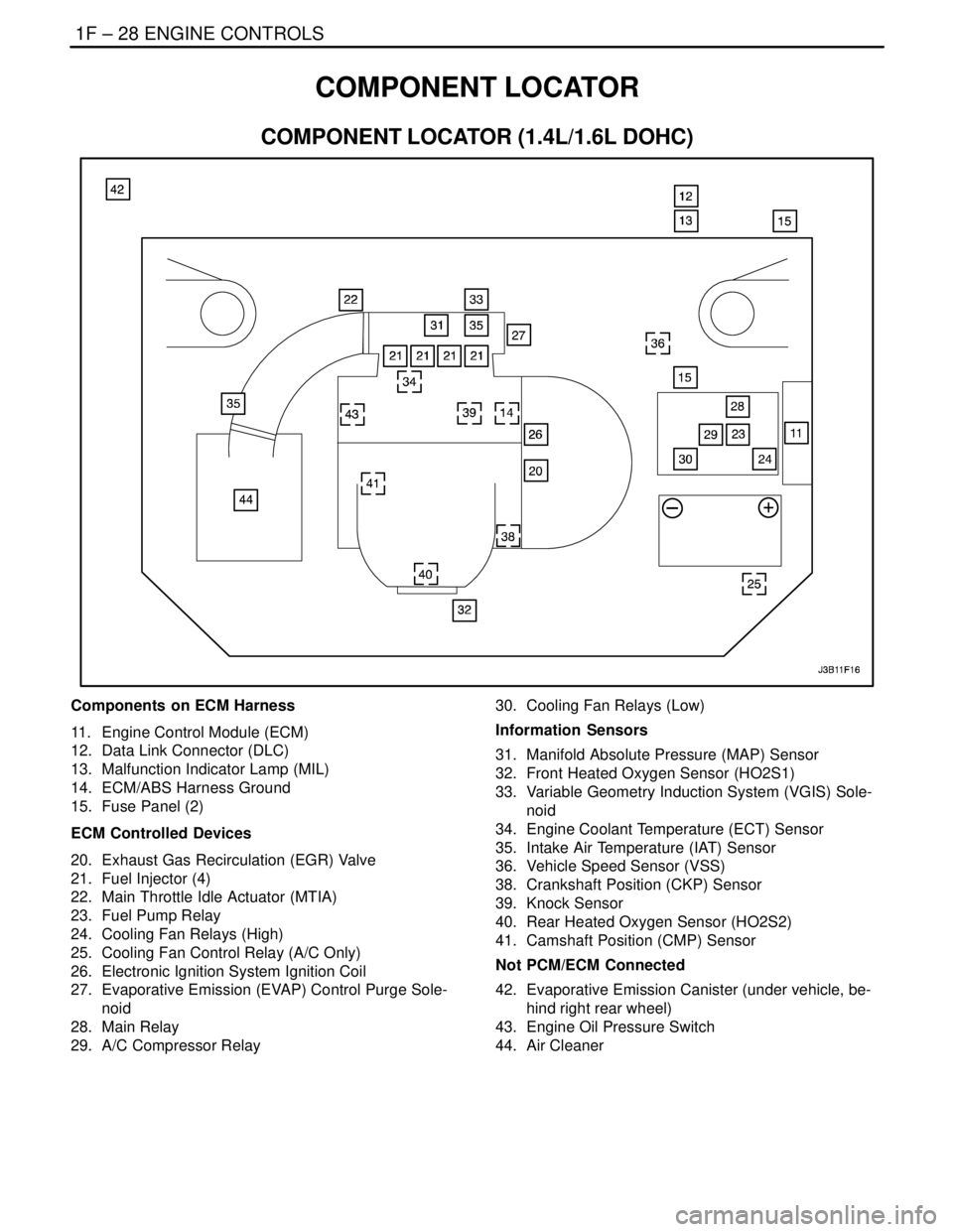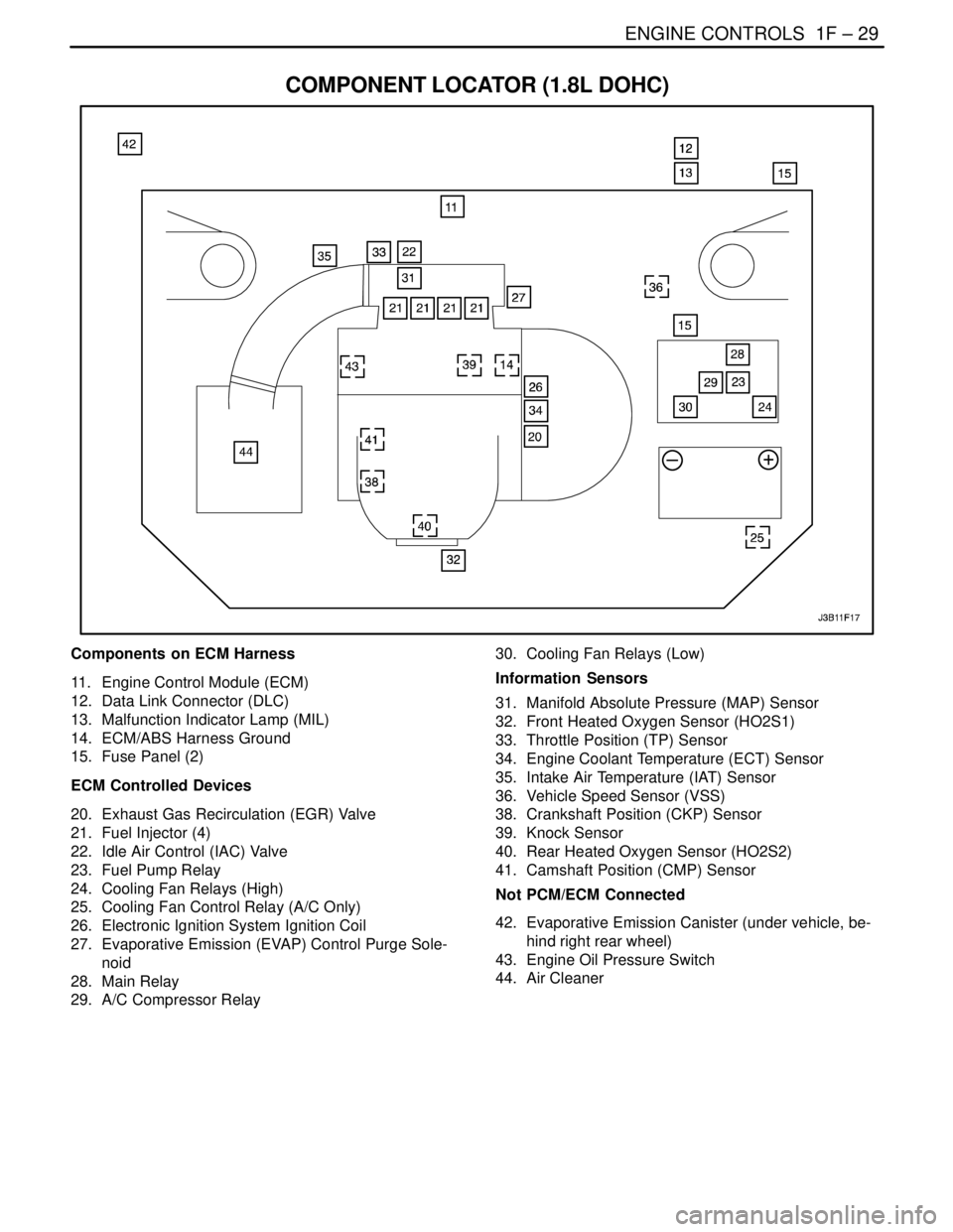2004 DAEWOO LACETTI wheel
[x] Cancel search: wheelPage 274 of 2643

1F – 28IENGINE CONTROLS
DAEWOO V–121 BL4
COMPONENT LOCATOR
COMPONENT LOCATOR (1.4L/1.6L DOHC)
Components on ECM Harness
11. Engine Control Module (ECM)
12. Data Link Connector (DLC)
13. Malfunction Indicator Lamp (MIL)
14. ECM/ABS Harness Ground
15. Fuse Panel (2)
ECM Controlled Devices
20. Exhaust Gas Recirculation (EGR) Valve
21. Fuel Injector (4)
22. Main Throttle Idle Actuator (MTIA)
23. Fuel Pump Relay
24. Cooling Fan Relays (High)
25. Cooling Fan Control Relay (A/C Only)
26. Electronic Ignition System Ignition Coil
27. Evaporative Emission (EVAP) Control Purge Sole-
noid
28. Main Relay
29. A/C Compressor Relay30. Cooling Fan Relays (Low)
Information Sensors
31. Manifold Absolute Pressure (MAP) Sensor
32. Front Heated Oxygen Sensor (HO2S1)
33. Variable Geometry Induction System (VGIS) Sole-
noid
34. Engine Coolant Temperature (ECT) Sensor
35. Intake Air Temperature (IAT) Sensor
36. Vehicle Speed Sensor (VSS)
38. Crankshaft Position (CKP) Sensor
39. Knock Sensor
40. Rear Heated Oxygen Sensor (HO2S2)
41. Camshaft Position (CMP) Sensor
Not PCM/ECM Connected
42. Evaporative Emission Canister (under vehicle, be-
hind right rear wheel)
43. Engine Oil Pressure Switch
44. Air Cleaner
Page 275 of 2643

ENGINE CONTROLS 1F – 29
DAEWOO V–121 BL4
COMPONENT LOCATOR (1.8L DOHC)
Components on ECM Harness
11. Engine Control Module (ECM)
12. Data Link Connector (DLC)
13. Malfunction Indicator Lamp (MIL)
14. ECM/ABS Harness Ground
15. Fuse Panel (2)
ECM Controlled Devices
20. Exhaust Gas Recirculation (EGR) Valve
21. Fuel Injector (4)
22. Idle Air Control (IAC) Valve
23. Fuel Pump Relay
24. Cooling Fan Relays (High)
25. Cooling Fan Control Relay (A/C Only)
26. Electronic Ignition System Ignition Coil
27. Evaporative Emission (EVAP) Control Purge Sole-
noid
28. Main Relay
29. A/C Compressor Relay30. Cooling Fan Relays (Low)
Information Sensors
31. Manifold Absolute Pressure (MAP) Sensor
32. Front Heated Oxygen Sensor (HO2S1)
33. Throttle Position (TP) Sensor
34. Engine Coolant Temperature (ECT) Sensor
35. Intake Air Temperature (IAT) Sensor
36. Vehicle Speed Sensor (VSS)
38. Crankshaft Position (CKP) Sensor
39. Knock Sensor
40. Rear Heated Oxygen Sensor (HO2S2)
41. Camshaft Position (CMP) Sensor
Not PCM/ECM Connected
42. Evaporative Emission Canister (under vehicle, be-
hind right rear wheel)
43. Engine Oil Pressure Switch
44. Air Cleaner
Page 277 of 2643

ENGINE CONTROLS 1F – 31
DAEWOO V–121 BL4
TEC (TOOTH ERROR CORRECTION)
LEARN PROCEDURE
When an ECM is reflashed, initialized or replaced, and dri-
veplate of fly wheel has been replaced, follow these proce-
dures to relearn the crankshaft position (CKP) system
variation :
CAUTION : To avoid personal injury when performing
the TEC learn procedure, always set the vehicle park-
ing brake and block the drive wheels. Release the
throttle immediately when the engine starts to decel-
erate. Once the learning procedure is completed, en-
gine control will be learned to the operator, and the
engine will respond to throttle position.1. Stay the gear parking or neutral.
2. Install the scan tool and select ”TEC (Toth Error
Correction) LEARN” menu.
3. Start the engine with A/C off.
4. Keep the engine coolant temperature above 65°C
(149° F)
5. Put the acceleration pedal above 4000 RPM until
the fuel cut–off occurs.
6. Wait 10–15 seconds.
7. Fulfill this procedure again if the scan tool does not
display ”OK” message.
8. Turn the ignition switch OFF.
9. Turn the ignition swtich ON and then clear the DTC
code.
Page 331 of 2643

ENGINE CONTROLS 1F – 85
DAEWOO V–121 BL4
IGNITION SYSTEM CHECK (1.4L/1.6L DOHC)
Circuit Description
The Electronic Ignition (EI) system uses a waste spark
method of spark distribution. In this type of EI system, the
Crankshaft Position (CKP) sensor is mounted to the oil
pump near a slotted wheel that is a part of the crankshaft
pulley. The CKP sensor sends reference pulses to the en-
gine control module (ECM). The ECM then triggers the EI
system ignition coil. Once the ECM triggers the EI system
ignition coil, both of the connected spark plugs fire at the
same time. One cylinder is on its compression stroke at
the same time that the other is on the exhaust stroke, re-
sulting in lower energy needed to fire the spark plug in the
cylinder on its exhaust stroke.
This leaves the remainder of the high voltage to be used
to fire the spark plug in the cylinder on its compression
stroke. Since the CKP sensor is in a fixed position, timing
adjustments are not possible or needed.
Test Description
The number(s) below refer to step(s) on the diagnostictable.
2. It is important to check for the presence of spark to
all of the cylinders to isolate the problem to either
EI system ignition coil inputs or outputs.
5. In checking the ECM outputs for the electronic
spark timing signal, it recommended to use an os-
cilloscope to view the varying voltage signals. In
measuring these outputs with a voltmeter, intermit-
tent errors may occur that cannot be seen by a volt-
meter.
6. After confirming ECM inputs for the electronic spark
timing to the EI system ignition coil are OK, it can
be determined that a faulty EI system ignition coil is
at fault.
11. After confirming proper CKP sensor inputs to the
ECM and no wiring problems present, it can be de-
termined that the ECM is at fault.
24. This step, along with step 25, checks for battery
voltage and a ground to the EI system ignition coil.
Ignition System Check (1.4L/1.6L DOHC)
CAUTION : Use only electrically insulated pliers when handling ignition wires with the engine running to prevent
an electrical shock.
Step
ActionValue(s)YesNo
11. Remove the spark plugs.
2. Inspect for wet spark plugs, cracks, wear, im-
proper gap, burned electrodes, or heavy de-
posits.
3. Replace the spark plugs as needed.
Is the repair complete?–System OKGo to Step 2
2Check for the presence of spark from all of the igni-
tion wires while cranking the engine.
Is spark present from all of the ignition wires?–System OKGo to Step 3
31. Measure the resistance of the ignition wires.
2. Replace any ignition wire(s) with a resistance
above the value specified.
3. Check for the presence of spark from all of the
ignition wires.
Is spark present from all of the ignition wires?30,000 WSystem OKGo to Step 4
4Is spark present from at least one of the ignition
wires, but not all of the ignition wires?–Go to Step 5Go to Step 12
51. Turn the ignition OFF.
2. Disconnect the Electronic Ignition (EI) system
ignition coil connector.
3. While cranking the engine, measure the volt-
age at the EI system ignition coil connector
terminal 1.
Does the voltage fluctuate within the values speci-
fied?0.2–2.0 vGo to Step 6Go to Step 7
Page 334 of 2643

1F – 88IENGINE CONTROLS
DAEWOO V–121 BL4
IGNITION SYSTEM CHECK (1.8L DOHC)
Circuit Description
The Electronic Ignition (EI) system uses a waste spark
method of spark distribution. In this type of EI system, the
Crankshaft Position (CKP) sensor is mounted to the oil
pump near a slotted wheel that is a part of the crankshaft
pulley. The CKP sensor sends reference pulses to the en-
gine control module (ECM). The ECM then triggers the EI
system ignition coil. Once the ECM triggers the EI system
ignition coil, both of the connected spark plugs fire at the
same time. One cylinder is on its compression stroke at
the same time that the other is on the exhaust stroke, re-
sulting in lower energy needed to fire the spark plug in the
cylinder on its exhaust stroke.
This leaves the remainder of the high voltage to be used
to fire the spark plug in the cylinder on its compression
stroke. Since the CKP sensor is in a fixed position, timing
adjustments are not possible or needed.
Test Description
The number(s) below refer to step(s) on the diagnostictable.
2. It is important to check for the presence of spark to
all of the cylinders to isolate the problem to either
EI system ignition coil inputs or outputs.
5. In checking the ECM outputs for the electronic
spark timing signal, it recommended to use an os-
cilloscope to view the varying voltage signals. In
measuring these outputs with a voltmeter, intermit-
tent errors may occur that cannot be seen by a volt-
meter.
6. After confirming ECM inputs for the electronic spark
timing to the EI system ignition coil are OK, it can
be determined that a faulty EI system ignition coil is
at fault.
11. After confirming proper CKP sensor inputs to the
ECM and no wiring problems present, it can be de-
termined that the ECM is at fault.
24. This step, along with step 25, checks for battery
voltage and a ground to the EI system ignition coil.
Page 434 of 2643

1F – 188IENGINE CONTROLS
DAEWOO V–121 BL4
DIAGNOSTIC TROUBLE CODE (DTC) P0300
MULTIPLE CYLINDER MISFIRE (CATALYST DAMAGE)
System Description
The Engine Control Module (ECM) monitors the crank-
shaft and camshaft positions to detect if the engine is mis-
firing. The ECM looks for a quick drop in crankshaft speed.
This test is executed in blocks of 200 engine revolution
tests. It may take between one to several tests to store a
Diagnostic Trouble Code (DTC), the Malfunction Indicator
Lamp (MIL). Severe misfire will flash the MIL, indicating
that catalyst damage is possible.
Conditions for Setting the DTC
S The engine speed is less than 4,500 rpm.
S The fuel tank level is greater than 20%.
S No anti–jerk correction.
S No rough road detection.
S No crankshaft oscillation detection.
S DTCs P0107, P0108, P0122, P0123, P0341,
P0342, P0336 and P0337 are not set.
Action Taken When the DTC SetsS The malfunction Indicator Lamp (MIL) will blinking.
S The ECM will record operating conditions at the
time the diagnostic fails. The information will be
stored in the Freeze Frame and Failure Records
buffers.
S A history DTC is stored.
Conditions for Clearing the MIL/DTC
S A history DTC will clear after 40 consecutive warm
up cycles without a fault.
S DTC(s) can be cleared by using the scan tool.
S Disconnecting the ECM battery feed for 10 sec-
onds.
Diagnostic Aids
An intermittent can also be the result of a defective reluctor
wheel. Remove the CKP sensor and inspect the reluctor
wheel through the sensor mount hole. Check for porosity
and the condition of wheel. If the DTC is intermittent refer
to ”Symptoms Diagnosis” in this section.
DTC P0300 – Multiple Cylinder Misfire(Catalyst Damage)
StepActionValue(s)YesNo
1Perform an Euro On–Board Diagnostic (EOBD)
System Check.
Was the check performed?–Go to Step 2Go to
”On–Board
Diagnostic Sys-
tem Check”
21. Install a scan tool to the Data Link Connector
(DLC).
2. Turn the ignition ON, with the engine OFF.
3. Request Diagnostic Trouble Codes (DTCs).
Are DTCs P0261, P0262, P0264, P0265, P0267,
P0268, P0270, P0271 set?–Go to
Applicable DTC
tableGo to Step 3
3Perform a visual/physical inspection.
Make any repairs that are necessary.
Is the repair complete?–Go to Step 27Go to Step 4
4Start the engine and allow it to idle.
Are any Misfire Current counters incrementing?–Go to Step 5Go to Step 6
5Are all counters equal (within a percentage of each
other)?–Go to Step 7Go to Step 11
61. Turn the ignition ON, with the engine OFF.
2. Review the Freeze Frame data, and note the
parameters.
3. Operate the vehicle within the Freeze Frame
conditions and conditions for setting this DTC
as noted.
Are any Misfire Current counters incrementing?–Go to Step 5Go to
”Diagnostic
Aids”
Page 438 of 2643

1F – 192IENGINE CONTROLS
DAEWOO V–121 BL4
DIAGNOSTIC TROUBLE CODE (DTC) P0300
MULTIPLE CYLINDER MISFIRE (INCREASE EMISSION)
System Description
The Engine Control Module (ECM) monitors the crank-
shaft and camshaft positions to detect if the engine is mis-
firing. The ECM looks for a quick drop in crankshaft speed.
This test is executed in blocks of 1,000 engine revolution
tests. It may take between one to several tests to store a
Diagnostic Trouble Code (DTC) and illuminate the Mal-
function Indicator Lamp (MIL).
Conditions for Setting the DTC
S The engine speed is less than 4,500 rpm.
S The fuel tank level is greater than 20%.
S No anti–jerk correction.
S No rough road detection.
S No crankshaft oscillation detection.
S DTCs P0107, P0108, P0122, P0123, P0341,
P0342, P0336 and P0337 are not set.
Action Taken When the DTC Sets
S The Malfunction Indicator Lamp (MIL) will illuminate
after three consecutive trip with a fail.S The ECM will record operating conditions at the
time the diagnostic fails. The information will be
stored in the Freeze Frame and Failure Records
buffers.
S A history DTC is stored.
Conditions for Clearing the MIL/DTC
S The MIL will turn off after four consecutive ignition
cycles in which the diagnostic runs without a fault.
S A history DTC will clear after 40 consecutive warm
up cycles without a fault.
S DTC(s) can be cleared by using the scan tool.
S Disconnecting the ECM battery feed for 10 sec-
onds.
Diagnostic Aids
An intermittent can also be the result of a defective reluctor
wheel. Remove the CKP sensor and inspect the reluctor
wheel through the sensor mount hole. Check for porosity
and the condition of wheel. If the DTC is intermittent refer
to ”Symptoms Diagnosis” in this section.
DTC P0300 – Multiple Cylinder Misfire(Increase Emission)
StepActionValue(s)YesNo
1Perform an Euro On–Board Diagnostic (EOBD)
System Check.
Was the check performed?–Go to Step 2Go to
”On–Board
Diagnostic Sys-
tem Check”
21. Install a scan tool to the Data Link Connector
(DLC).
2. Turn the ignition ON, with the engine OFF.
3. Request Diagnostic Trouble Codes (DTCs).
Are DTCs P0261, P0262, P0264, P0265, P0267,
P0268, P0270, P0271 set?–Go to
Applicable DTC
tableGo to Step 3
3Perform a visual/physical inspection.
Make any repairs that are necessary.
Is the repair complete?–Go to Step 27Go to Step 4
4Start the engine and allow it to idle.
Are any Misfire Current counters incrementing?–Go to Step 5Go to Step 6
5Are all counters equal (within a percentage of each
other)?–Go to Step 7Go to Step 11
61. Turn the ignition ON, with the engine OFF.
2. Review the Freeze Frame data, and note the
parameters.
3. Operate the vehicle within the Freeze Frame
conditions and conditions for setting this DTC
as noted.
Are any Misfire Current counters incrementing?–Go to Step 5Go to
”Diagnostic
Aids”
Page 504 of 2643

1F – 258IENGINE CONTROLS
DAEWOO V–121 BL4
S Damaged terminals
S Poor terminal to wire connection
S Physical damage to the wiring harness
Ensure the VSS is correctly torqued to the trnasaxle hous-ing.
Refer to ”Intermittents” in this section.
DTC P0501 – Vehicle Speed No Signal (M/T Only)
StepActionValue(s)YesNo
1Perform an Euro On–Board Diagnostic (EOBD)
System Check.
Is the system check complete?–Go to Step 2Go to
”On–Board
Diagnostic Sys-
tem Check”
2Notice : Running the vehicle in gear with the wheels
hanging down at full travel will damage the drive
axles.
1. Turn the ignition ON, with the engine OFF.
2. Install a scan tool.
3. Raise the drive wheels.
4. Support the lower control arms so that the
drive axles are in a horizontal (straight) posi-
tion.
5. Allow the engine to idle in gear.
Does the scan tool display vehicle speed above the
specified value?0 mphGo to Step 3Go to Step 4
31. Turn the ignition ON, with the engine OFF.
2. Review the Freeze Frame data and note the
parameters.
3. Operate the vehicle within the Freeze Frame
conditions and Conditions for Setting this DTC.
Does the scan tool display the vehicle speed above
the specified value?0 mphGo to Step 12Go to Step 4
41. Turn the ignition OFF.
2. Disconnect the engine control module(ECM)
connector 51.
3. Using a digital voltmeter(DVM) connected to
ground, measure the voltage in the Vehicle
Speed Sensor (VSS) signal circuit, at terminal
C while rotating the wheels.
Is the voltage greater than or eqaul to specified val-
ue?0.5VGo to Step 12Go to Step 5
5Measure the resistant in the VSS signal circuit while
rotating the wheels.
Is the resistance greater than the specified value?1950WGo to Step 6Go to Step 7
6Check the VSS signal circuit for an open and repair
as necessary.
Is the repair complete?–Go to Step 12Go to Step 9
7Is the resistance value within or equal to the speci-
fied value?1300–1950WGo to Step 8Go to Step 9
8Check the VSS signal circuit for a short to ground or
for being shorted together and repair as necessary.
Is a repair necessary?–Go to Step 12Go to Step 12
91. Remove the VSS.
2. Measure the resistance between terminals A
and C.
Is the resistance value within the specified value?1300–1950WGo to Step 11Go to Step 10